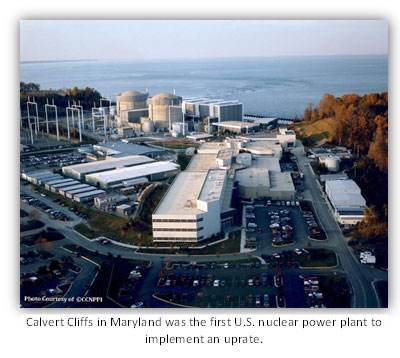Reactor Power Uprate: A Guide To The NRC Application Process

Table of Contents
Understanding the NRC's Regulatory Framework for Reactor Power Uprates
The NRC establishes stringent safety and environmental standards for reactor power uprates, prioritizing public safety and environmental protection. Before initiating your application, a thorough understanding of these regulations is paramount. This involves familiarizing yourself with key legal documents and guidelines, and proactively engaging with the NRC.
-
Key Regulatory Documents:
- 10 CFR Part 50: This section of the Code of Federal Regulations governs the licensing of production and utilization facilities, including the requirements for power uprates. A deep understanding of its stipulations is crucial for a successful application.
- Regulatory Guides: The NRC publishes numerous regulatory guides offering detailed guidance on specific aspects of power uprates and safety analyses. These documents provide valuable insights and best practices.
- Compliance is Key: Demonstrating unwavering compliance with all applicable regulations is non-negotiable. Any deviation requires meticulous justification and supporting documentation.
-
Navigating the NRC Review Process: The NRC's review process is rigorous and thorough. Understanding their timelines and expectations is crucial for effective planning. This includes:
- Understanding the phased review process and potential delays.
- Preparing for potential requests for additional information (RAI).
- Proactive communication with the NRC staff to address any concerns early on.
- Planning for pre-application consultations to identify potential hurdles before formal submission.
Preparing a Comprehensive NRC Application for Reactor Power Uprate
A meticulously prepared application is the cornerstone of a successful reactor power uprate. This involves compiling comprehensive documentation demonstrating the safety and environmental soundness of your proposed power increase. Key elements include:
- Safety Analysis Report (SAR): This document is the heart of your application. It needs to provide a detailed safety analysis, justifying the proposed power increase. We’ll delve deeper into the SAR's components in the next section.
- Technical Specifications: These specifications detail the modified operational parameters for the plant at the increased power level, outlining safe operating limits and procedures.
- Environmental Impact Statement (EIS): A thorough assessment of the potential environmental impacts is mandatory. This evaluation should consider potential effects on air and water quality, wildlife, and the surrounding ecosystem. It should also include mitigation strategies.
- Plant Modifications: Comprehensive documentation outlining all proposed modifications to plant equipment and systems is crucial for demonstrating the safety and reliability of the upgraded facility. This includes detailed design specifications, engineering analysis and vendor documentation.
- Qualified Personnel: Having a team of qualified personnel experienced in nuclear power plant operations and regulatory compliance is essential for a successful application. Their expertise should be clearly outlined within the application.
Key Elements of the Safety Analysis Report (SAR)
The SAR forms the foundation of your safety case to the NRC. It needs to be comprehensive and thoroughly address all potential safety concerns. The key elements include:
- Transient Analysis: This evaluates the plant's response to various operational transients (unexpected events) at the increased power level. It must demonstrate that the plant can safely handle these situations.
- Accident Analysis: A detailed evaluation of potential accidents, including their likelihood and consequences, is crucial. This should include analyses of both initiating events and accident progression, considering the effects on safety systems. Mitigation strategies must also be clearly defined.
- Safety Systems Evaluation: A thorough assessment of the plant's safety systems and their performance at the increased power level. This ensures that the safety systems remain effective and reliable even with increased power output.
- Design Change Justification: Any proposed design changes must be thoroughly justified, demonstrating that they enhance safety and reliability without introducing new risks.
- Addressing Safety Concerns: The SAR must proactively address all potential safety concerns identified during the analysis, providing clear and convincing justifications for the proposed solutions.
Navigating the NRC Review and Approval Process
The NRC review process is multifaceted, involving several stages. Proactive communication and collaboration with the NRC are vital for a smooth and efficient process. Key stages include:
- Initial Review: The NRC will conduct an initial review of your application, potentially requesting additional information to clarify certain aspects.
- Meetings and Conferences: You should expect participation in meetings and conferences with NRC staff to discuss the application's details and address any concerns.
- Addressing NRC Concerns: Respond to all NRC concerns promptly and thoroughly. Incorporating suggested modifications is a vital part of the process.
- Approvals and Licenses: Once the NRC is satisfied, they will issue the necessary approvals and licenses, allowing you to proceed with the power uprate.
- Post-Approval Monitoring: Even after approval, ongoing compliance and monitoring are essential. The NRC will continue to oversee operations, ensuring that the plant continues to meet safety standards.
Post-Uprate Operations and Ongoing Compliance
Maintaining regulatory compliance after the power uprate is paramount. This involves establishing new procedures and ensuring consistent monitoring. Key aspects of post-uprate operations include:
- New Operational Procedures: Implement new operating procedures reflecting the increased power level, including updated safety protocols and emergency plans.
- Record Keeping and Reporting: Maintain meticulous records and submit regular reports to the NRC, ensuring transparency and accountability.
- Plant Performance Monitoring: Continuous monitoring of plant performance and safety parameters is essential to identify and address any potential issues promptly.
- Addressing Unforeseen Issues: Develop procedures for dealing with any unforeseen issues that may arise after the power uprate.
- Regulatory Updates: Stay informed about changes in NRC regulations and adjust your operations accordingly.
Conclusion
Successfully achieving a reactor power uprate requires careful planning, thorough preparation, and a deep understanding of the NRC's regulatory framework. This process necessitates a comprehensive application, meticulous attention to detail, and proactive engagement with the NRC. By following the steps outlined in this guide and addressing potential challenges proactively, you can optimize your chances of a successful reactor power uprate, leading to enhanced energy production and operational efficiency. Contact us today to learn more about how we can assist you with your reactor power uprate application and ensure your compliance with all NRC regulations. Expert guidance is crucial for navigating the complexities of the reactor power uprate process. Remember, a successful nuclear reactor upgrading requires comprehensive planning and regulatory expertise.

Featured Posts
-
 Viral Posts Spark Concern Among Kashmirs Cat Owners
May 01, 2025
Viral Posts Spark Concern Among Kashmirs Cat Owners
May 01, 2025 -
 Kentucky Storm Damage Assessments Delays And Reasons Explained
May 01, 2025
Kentucky Storm Damage Assessments Delays And Reasons Explained
May 01, 2025 -
 Historic Charlotte Barn For Sale Farmers And Foragers Legacy Continues
May 01, 2025
Historic Charlotte Barn For Sale Farmers And Foragers Legacy Continues
May 01, 2025 -
 Il Caso Becciu Chat Segrete Complotto E Processo Cosa E Successo
May 01, 2025
Il Caso Becciu Chat Segrete Complotto E Processo Cosa E Successo
May 01, 2025 -
 Shrimp Ramen Stir Fry Customizable Recipe
May 01, 2025
Shrimp Ramen Stir Fry Customizable Recipe
May 01, 2025
